Recently, in order to promote and standardize hospital information construction, the National Health and Health Commission has formulated the "National Hospital Informationization Construction Standards and Regulations (Trial)" referred to as "Construction Standards". The document consists of 5 chapters and 22 categories, with a total of 262 specific contents, which clarifies the construction content and construction requirements of the next stage hospital informationization.
In the past, there was no standard to rely on. Most medical information enterprises crossed the river by feeling the stones. The marketization risk after product development was great, and this document guides the direction of enterprise product development.
Through reference to the contents of the document, the company can more clearly understand the needs of the hospital in the information construction in the future product development, and can more accurately find the sub-area where the research and development products are located, and understand the products in the current information construction process. The development stage of the department will help to further analyze market demand and future development trends.
According to the second-level, third-grade B, and third-grade hospitals, the paper puts forward specific construction requirements, so that the hospital informationization construction has rules to follow. If the products developed by the enterprise meet the requirements of the document, the market acceptance will be higher. Enterprises can also have a reference when looking for the corresponding target customers.
The unified standard creates conditions for the interactive sharing of data between different hospitals, hospitals and regional platforms, further promotes the interconnection of hospital information, and also provides a more convenient channel for cooperation between enterprises and enterprises.
Indicator system diagram of "National Hospital Informationization Construction Standards and Specifications"
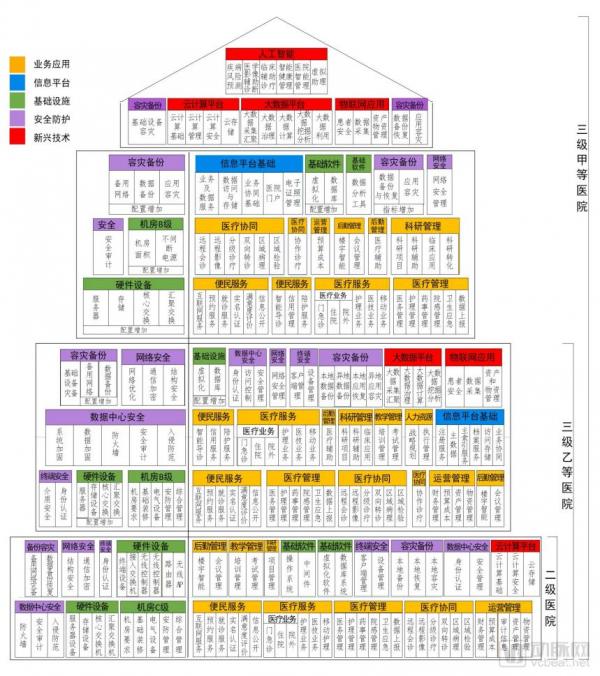
It can be seen that artificial intelligence, big data, internet of things and cloud computing as emerging technologies have appeared at the top of the top three informatization construction of the top three hospitals , which shows that this document attaches importance to these technologies.
Compared to the 2017 edition, the scened application begins to stand out
Compared with the "Guidelines for the Application of Hospital Informationization Construction (2017 Edition, Trial)", "National Hospital Informationization Construction Standards and Regulations (Trial)" has significantly strengthened emerging technologies such as big data, artificial intelligence, and Internet of Things in tertiary hospitals. The idea of ​​the scene construction.
For the scenario mentioned in this “Building Standardsâ€, the arterial network adopts the form of anonymous voucher, inviting dozens of directors of the top domestic hospital information departments and industry company technical leaders to address maturity, complexity, and potential. The values ​​were scored comprehensively. This result can objectively reflect the future direction of medical big data , artificial intelligence and the Internet of Things.
Big Data
In the "Building Standards", the specific content and requirements of big data are as follows:

Compared with the past, this "Building Standard" has made detailed requirements for the whole link of big data from collection, management, calculation, mining analysis, utilization and tool use.
The big data application scenarios extracted from specific standards are as follows:

After synthesizing the anonymous questionnaire of the director of the hospital information department and the enterprise technology or project leader, the arterial network obtained the following score judgments based on the technical maturity, complexity and development potential value:

At present, people in the industry are most optimistic about the development and application of big data in disease diagnosis and treatment and research. However, in terms of implementation difficulty, clinical assistant decision-making and multidisciplinary collaborative diagnosis and treatment (MDT) are the most difficult to achieve. Especially in the former, the technical maturity is still relatively low at present, and there are few products that can be used in the doctor's disease diagnosis and treatment.
In this document, Wang Yuyu, chief product officer of Bozhi Medical Cloud, judged that the standard emphasizes the standardization and quality control of electronic medical records in many places. The increased emphasis on electronic medical records in the country is conducive to enterprises to promote specialized disease structured electronic medical records.
Specialized structured electronic medical records are the preconditions for the application of big data. Only when high-quality data is collected can it be discussed.
At present, domestic medical big data companies are involved in these six major scenarios. Wang Yuyu gave his own views on different scenarios. He believed that the first two items could be defined as the intelligent processing of existing data at the hospital level. This is part of the company's efforts, because this part of the data is both existing and already Among the stored hospital HIS systems, they have not been fully and effectively utilized.
The last four items can be defined as intelligent processing of structured panoramic data, which contains two elements: one is structured data, and the other is panoramic data, not only in-hospital data, but also out-of-hospital follow-up data, health data, patient genes. Data, etc.
In addition, since the data acquisition difficulty of the last four items is much higher than the previous two items, the clinically auxiliary decision diagnosis in the actual sense is the least. Even if the existing data in the hospital is 100% structured through NLP, it is not enough to support clinical decision-making and needs to meet the elements of the second panoramic data. This is why the medical knowledge cloud has to be structured to collect panoramic medical data from structured medical records.
In terms of disease analysis and scientific research, the research project of the 302th Hospital of the People's Liberation Army is a good case.
In 2015, based on the research needs of the central tumor database of liver cancer and cholangiocarcinoma, the Chinese Academy of People's Liberation Army No. 302 Hospital Liver Cancer Diagnosis and Treatment Center, the Chinese Research Hospital Association, the Molecular Diagnostic Medicine Committee and the Bozhi Medical Cloud cooperated for one year. Created a big data platform for cholangiocarcinoma. The platform realizes the comprehensive integration of patient diagnosis and treatment information, imaging data, pathological diagnosis, metabolomics and genetic testing data.
At present, 302 hospital cholangiocarcinoma big data platform has accumulated more than 1000 cases of cholangiocarcinoma patients with structured medical records and omics data. On this basis, the hospital integrates domestic and international clinical diagnosis and treatment guidelines and research results. The center uses intelligent analysis and mining systems to assist in machine learning and deep learning, and successfully constructs a new "chondal cell cancer disease risk and one-year survival rate estimate". The mathematical model provides a basis for data and diagnosis and treatment for clinical treatment evaluation and prognosis risk prediction of patients with cholangiocarcinoma.
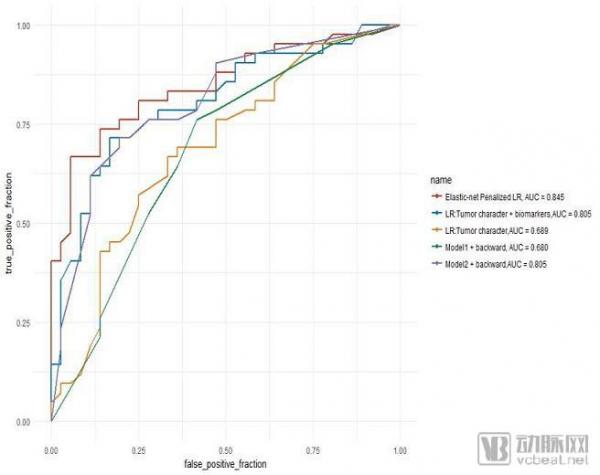
EN's AUC peak is optimal
For example, the doctor inputs some key patient information, including tumor characteristics, patient personal information, laboratory indicators, and test index data. Through the product, the patient's diagnosis and grading recommendations can be obtained, including what kind of treatment the patient should do, and what will happen. What is the one-year survival rate?
In terms of clinical decision support, Zerobow's Hubble artificial intelligence assisted decision-making system is highly representative.
Zero æ°ª By applying the patient's real case data and algorithm model to tumor treatment, constructing accurate diagnosis and treatment models and providing data support, it can assist hospital management decision-making, assist research, and assist clinical diagnosis and treatment.
At present, the Hubble system "Lung Cancer Lymph Node Jumping Metastasis Risk Prediction" module can prevent lung cancer patients from recurring 8-10 months in advance due to misjudgment, and can extend the life of nearly 20,000 patients for another 8-10 months each year; Hubble The system "AI-Pulmonary Nodule Intelligent Diagnosis" module fully recognizes all nodules in CT images with a recognition rate of 91.5%.
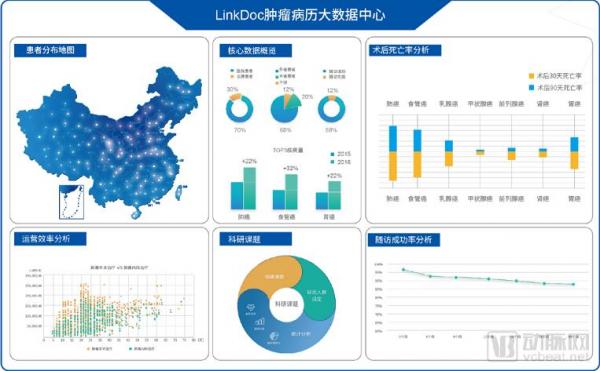
Hubble artificial intelligence assisted decision making system display page
Hou Bolin, director of clinical operations of Zero Data Technology Medical Data, told the Arterial Network reporter that the company initially used NLP technology in the field of medical big data, combined with medical knowledge maps and a large number of manual annotations, to carry out deep structural processing of clinical original medical records. Through a rigorous data processing system, a high-quality clinical big data queue is formed, and finally an effective application based on big data is realized.
Zero is mainly focused on scientific research based on clinical data, as well as the application of artificial intelligence in assisted diagnosis and treatment. For the hospital's operation management, hospital governance, including real-time statistical analysis, zero is involved.
At present, research is still the key demand of hospitals. Since the construction of the hospital CDR has just started, the available data platform is not perfect, so there is no relatively clear data utilization idea. Only the research platform, the current application is relatively mature. According to the zero plan, future disease analysis, scientific research and auxiliary diagnosis will be the main focus of zero.
Multidisciplinary Collaborative Diagnosis and Treatment (MDT) is also one of the application scenarios in the current exploration of big data. Taking tumors as an example, the treatment of tumors is a comprehensive treatment. The medical records of single departments have limitations in value. If the data of multi-disciplinary MDTs will greatly improve the evidence level of the data.
There are also examples in this regard. Peking University Cancer Hospital has developed a MDT component tool for multidisciplinary discussions based on the knowledge of the underlying technology of the medical cloud and the practical experience of multidisciplinary discussions.
With this tool, doctors can use data analysis to determine the cross-validation between different departments, different doctors, and different medical record forms. From different dimensions, MDT can be realized and ultimately benefit patients.
artificial intelligence
In the "Building Standards", the specific content and requirements of artificial intelligence are as follows:
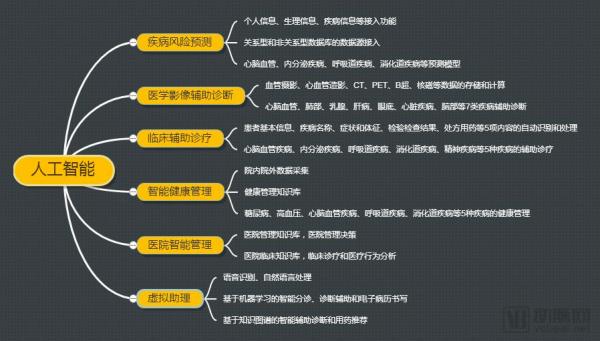
Compared with the past, this "Building Standard" defines the application of artificial intelligence in various imaging equipment and important diseases. Its central cerebrovascular, lung, liver disease, breast, fundus and heart are the key disease directions of the image. In terms of chronic disease management, artificial intelligence has application scenarios for health management in diabetes, hypertension, cardiovascular and cerebrovascular diseases, respiratory diseases, and digestive tract diseases.
From the specific criteria, the six application scenarios of artificial intelligence extracted from the arterial network are as follows:

After synthesizing the anonymous questionnaire of the director of the hospital information department and the enterprise technology or project leader, the arterial network obtained the following score judgments based on the technical maturity, complexity and development potential value:
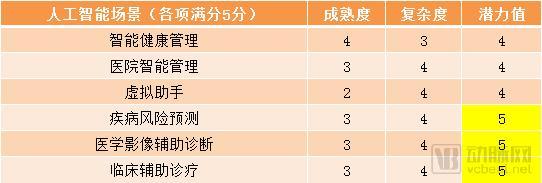
According to the survey results, people in the industry are currently most optimistic about artificial intelligence in the auxiliary diagnosis and treatment of diseases. In terms of technical difficulty, various scenes are basically flat. Intelligent health management is currently the most mature area.
For this "Building Standard", Yasen CEO Chen Hui gave his own opinion. He believes that this document has a good role in promoting the direction and clinical application of artificial intelligence and the improvement of China's medical system.
At present, the diagnosis of specific disease-specific AI products, such as Alzheimer's disease or specific diseases of cardiovascular and cerebrovascular diseases, is relatively lacking, and everyone concentrates on image-assisted quantitative analysis.
Artificial intelligence companies should put disease risk predictions first. Because the prognosis of many diseases in China is not ideal, in the final analysis, the links outside the treatment are not done well. For enterprises, it is more important to provide a good predictive analysis model for large-scale forecasting applications. Especially the heart and brain blood vessels, nerves, and geriatric diseases.
Chen Hui judged that the disease risk prediction will become a good landing scene, and it has a realistic landing scene in the medical examination center, the geriatric center, and the third-party inspection and inspection institutions.
In terms of medical imaging applications, this “Building Standards†clarifies the application of artificial intelligence in diseases such as cardiovascular and cerebrovascular, breast and lung, and the imaging data has also expanded to the dimensions of nuclear medicine and ultrasound. This prevents a large number of companies from getting together in a single image, leading to a disconnect between the company and the clinic.
From the perspective of the hospital, inspection, imaging, radiology, nuclear medicine, and pathology are all high-demand departments, but the application of artificial intelligence in clinical departments is as important as the medical technology department. Taking cardiovascular and cerebrovascular diseases as an example, whether to analyze the model and define the data based on clinical needs, rather than simply pushing from the technical point of view, is the direction that enterprises should try and expand.
It is reported that the future development of Yasen Technology includes two major directions: First, it must support the largest-scale primary hospitals, including the third-party inspection centers on the inspection projects; second, the actual incidence of brain science is very high, However, there is a lack of effective, long-term prediction and prognostic analysis to explore the field of exploration.
Because China's aging is a big problem, the early prediction of neurodegenerative diseases, risk management and even rehabilitation are very scarce. Even if the drug is not considered, this is a tens of billions of markets.
In response to the introduction of the "Building Standards", the Arterial Network also consulted experts in artificial intelligence at domestic universities and Professor Zhang Xuegong from the Department of Automation, School of Information, Tsinghua University. According to Professor Zhang, Tsinghua University is currently cooperating with Weining Health, a leading medical information technology company in the field of artificial intelligence.
He believes that in addition to imaging and pathology, psychiatry is also a good landing scene for artificial intelligence. In the past, doctors judged whether a patient had a mental problem and could only draw conclusions through the patient's way of thinking and logic. If you use speech recognition technology in artificial intelligence, you can try to use the machine to communicate with patients, similar to the Turing test.
Internet of Things
In the "Building Standards", the specific contents and requirements of the Internet of Things are as follows:
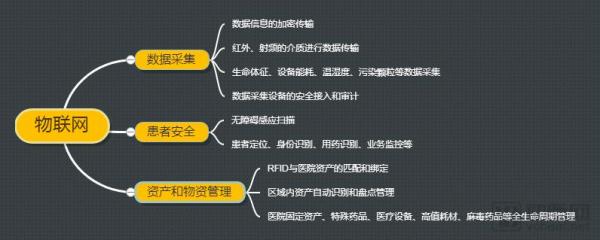
There are few standards related to the Internet of Things in the medical field.
In November 2010, the National Standardization Administration Committee and the National Development and Reform Commission jointly established the National IoT Basic Standards Working Group. The main responsibilities of the working group are to study the recommendations of the IoT technical architecture and standard system in line with China's national conditions, and propose the key technologies of the Internet of Things and the basic general technical standards for the revision and development of project proposals and standard development.
After the establishment of the National IoT Basic Standards Working Group, the first batch of 47 national standards for Internet of Things was promoted, of which 11 were related to medical care, as shown in the following table:

Although the standard was introduced earlier, it has not become a guiding standard for the medical industry . The announcement of the “Building Standards†of the Health and Health Commission is expected to improve the status quo of the industry.
The standard defines 21 scenarios for the Internet of Things, as follows:

According to the different characteristics of its product application scenarios, the arterial network divides the scene of IoT and medical integration into two major attributes, namely, positioning class and data monitoring class.
After synthesizing the anonymous questionnaire of the director of the hospital information department and the enterprise technology or project leader, the arterial network obtained the following score judgments based on the technical maturity, complexity and development potential value:
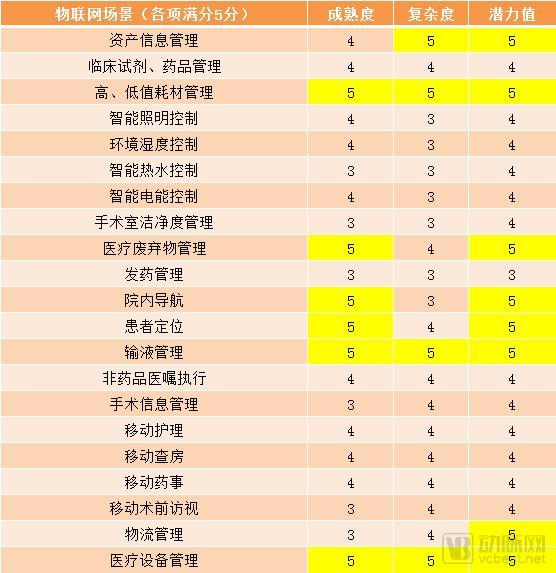
It can be seen from the survey results that the industry is most optimistic about hospital consumable equipment, as well as in-housing positioning and personnel positioning.
On this artery network, consulted Hu Xiaowei, Ruijie Network Medical Industry Solution Manager. He said that in recent years, the medical Internet of Things has become a big and difficult situation. This standard document clarifies the specific direction of landing, which plays a very important guiding significance for the landing of the medical Internet of Things in the next 5-10 years.
The current state of the industry is that patient safety, asset and material management are more directions for IoT solutions, and data acquisition related solutions are relatively rare.
In the medical environment, patient safety issues have always been the most concerned environment, including infusion monitoring, infant theft, and mental patient positioning. The more patients care, the more they can reduce the contradiction between doctors and patients and achieve benign medical treatment. surroundings.
Secondly, the asset and material management solutions, with the “13th Five-Year†medical reform, “health 2030â€, and other health and hygiene policies, intelligent and information-based hospitals are under construction at high speed, a large number of medical devices and information. Chemical products, high-value consumables, etc. are put into the medical environment and become important productivity and property of hospitals. Effective management of these important assets will become an important task for hospitals.
Hu Xiaowei said that no matter what stage the hospital is in, the management of hospital people and things is its most important component.
Person: Patient management and management of medical personnel directly affect the relationship between doctors and patients;
Matters: The management of important medical supplies such as medical devices and special drugs will reflect an important part of the professionalism of a hospital.
Therefore, the management of patient safety, materials and assets is a very worthwhile scenario for IoT medical companies. In the future, solutions such as hospital special patient management, medical staff management, medical waste management, and drug management will all be Ruijie exploration and in-depth scenarios.
Zheng Dong, the person in charge of IoT technology of Medical Technology, also gave a similar point. He said that the scene of the Internet of Things in the hospital is more about the positioning of people and property. Among them, the demand for positioning products for medical staff and patients is the largest, followed by material positioning.
The positioning of people and property is the foundation. On top of this, data is collected through various types of sensors. After the data is aggregated, the hospital can use the data center to achieve further analysis and planning.
For example, equipment assets, hospitals through the Internet of Things sensing technology, can find that some equipment is often used on a certain floor, and it takes a long time. After the data management analysis, the equipment management department can inform the hospital's procurement department about this situation and consider adding such equipment.
For the future development, Zheng Dong judged that due to the large differences in the standards of medical IoT equipment, the current data collection vendors have their own policies and are relatively closed. Medical Technology is currently pursuing a common platform for the Internet of Things. It hopes to break the limitations of the Internet of Things through the market advantage of enterprises and ultimately form the concept of a smart ward.
Traditional wards are biased towards clinical use, and the core is the health care staff, what they need to put. But the smart ward means patient-centered, ward-providing ward services including disease, light, air, temperature and humidity, and entertainment through sensors, infrared, and RFID tags.
Take personnel location management as an example, as a typical application of Wi-Fi technology and RFID technology in the medical industry. By strengthening the supervision of the location and dynamics of specific patients, it is truly “patient-centeredâ€.
The medical technology system realizes the refined and intelligent management of all kinds of hospitals, accurate RoomLevel and BedLevel positioning services, custom event mechanism and diversified reminding methods, which is more suitable for the actual application scenarios of the hospital. The perceptual information enriches medical information data and brings great convenience to the daily work of medical staff.
Common locators include: doctors, nurses, patients, newborns, and other medical workers.
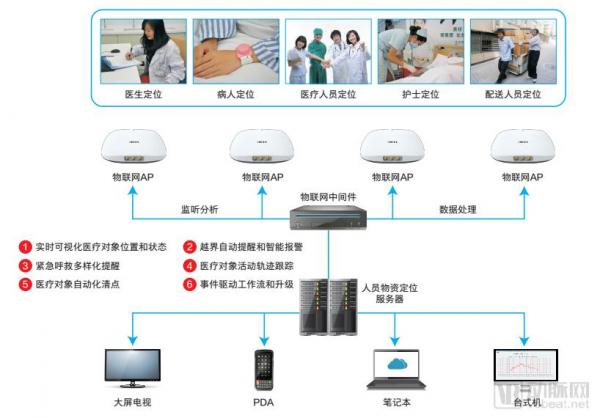
In addition, the number of newborns in the top three hospitals is generally high. If the effective logo is not used, it will often cause problems such as infants' wrong holding and baby stolen, which will have disastrous consequences for hospitals and infant families.
The Medical Benefits Baby Surveillance System matches mothers and babies by wearing active RFID remote tags for babies and mothers. Wherein maternal identity management information contained in the matching tag mother, the infant to the infant wearing the tag once the ankle, (without permission) privately removed, the system automatically generates an alarm. At the same time, the system can arrange the IoT AP to collect information about the baby in the baby activity space. Equipped with an exit monitor at the entrance and exit of the ward to achieve 24-hour monitoring of the baby in all directions and throughout the period.
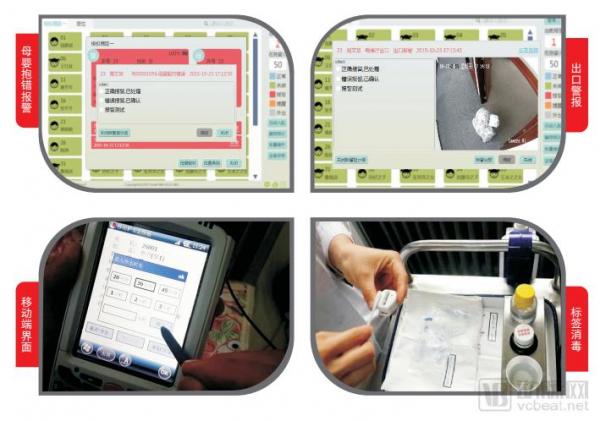
Unlike Ruijie Networks and Medical Technology, the head of Lianxin Medical Products interpreted this document from the concept of “Quality Careâ€.
He believes that quality and safety are the eternal focus of the medical industry and a necessary prerequisite for improving efficiency and improving the experience. The core of hospital management will gradually expand from “medical quality†to “patient safety management†throughout the process.
During the hospitalization of patients, their safety risks exist in various aspects such as diagnosis, medication, surgery, and nursing. Nearly 70% of the time is to deal with nursing staff. Therefore, “quality care†has been raised to the relevant policy level, and the state has accelerated the reform of the nursing model by establishing and recognizing measures such as quality care model wards.
On the other hand, the characteristics of nursing work - cumbersome, repetitive, mechanical labor, resulting in higher indirect nursing hours and lower direct nursing hours, the value of care is difficult to reflect, the patient experience is also poor, and the Internet of Things technology Can solve related problems for the nursing staff.
Among them, the data acquisition and transmission based on intelligent information recognition and matching is the most effective (such as infusion monitoring, physical sign collection, etc.), which has a significant effect on ensuring patient safety management, and is also the best brand building for smart hospitals. Focus.
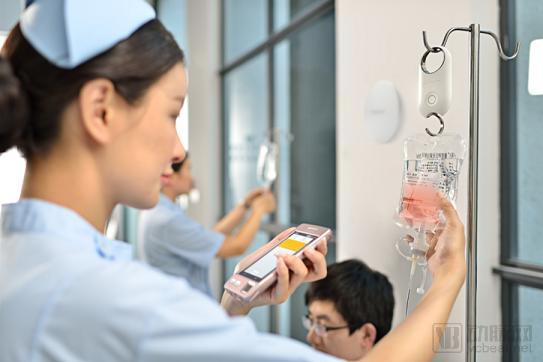
Intelligent infusion management
Therefore, Lianxin's current focus is on intelligent care as the core, providing hospitals with a total solution for smart wards. The overall positioning of the smart ward includes patient positioning, identification, remote monitoring of infusion, patient safety medication, and patient vital signs collection. These scenes are all based on the means of the Internet of Things to achieve quality care. Improving the quality of care is the highest priority in the hospital's intelligent upgrade process, and it is also the most worthwhile point to cut.
cloud computing
In the "Building Standards", the specific content and requirements of cloud computing are as follows:
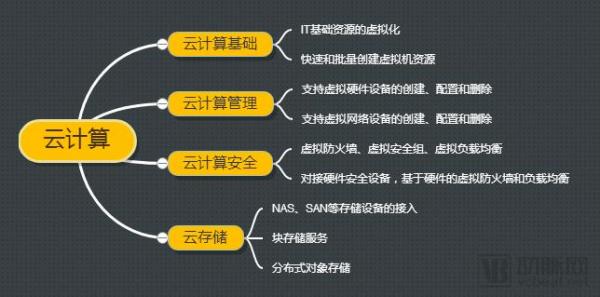
Since cloud computing is more of an underlying technology in the medical industry, there are no clear scenarios in the file.
Guo Shan, a partner at Jinshan Cloud, said that for cloud computing companies, this standard is neither difficult nor difficult. It is not difficult to say that because the functions required in the file cloud computing enterprises can basically provide, such as resource virtualization, rapid and batch creation of virtual machine resources.
It is difficult to say that because the function is only the basis, the higher requirement is whether the function is stable and reliable. The SLA (Service Level Agreement) that different cloud computing companies can achieve is high or low. For virtual machines and cloud storage services, service stability and data reliability are difficult to achieve 100%.
As we all know, the hospital's information system has extremely high requirements for service stability and data reliability, which requires cloud computing enterprises to have strong technical strength and large-scale cloud service experience. On the contrary, although the functions on the surface are available, in the production environment, problems will inevitably arise.
At present, Jinshan Cloud, as the top three cloud service providers in China's public cloud market, can provide SLAs of over 99.9% and data reliability of 99.999999999%.
In addition, Guo Wei also said that the standard is not much different from the standards of other industries. And the standards of the medical industry are more traditional than certain industries. Most of the current emerging industry to achieve a non-cloud-based "IOE" architecture, such as databases typically use a cloud database (RDS), rather than the traditional Oracle, SQL Server, and thus have higher self-controlled, but this standard There are no relevant requirements.
In summary, the National Hospital Information Technology Construction Standards and Regulations (Trial) standards issued by the National Health and Health Commission will serve as reference and guidance documents for domestic hospitals within a certain period of time. For the enterprise, this document is like a reassurance. With the direction, the market acceptance of the products is guaranteed.
Peptides For Bodybuilding,Peptides For Muscle Growth,Best Peptides For Bodybuilding,Collagen Peptides Bodybuilding
Shaanxi Hongbaiyi Biotech Co., Ltd. , https://www.sxhongbaiyi.com